"Open your heart to hatred. Open your mind to fury. Open your soul to the Dark Ones. Let not your forebears stand between you and the power that is offered. The sun has set on the Age of Chivalry, and the night that is to come belongs to those with the strength to assert their rule."
- —Canticle of the Warped Becoming, from the Liber Idolator
The Chaos Knights, also known as Renegade Knights, Daemon Knights, and the Questor Traitoris in High Gothic, are Imperial Knight combat walkers, their Fallen Noble pilots and Knight Houses corrupted to the service of Chaos. Humanoid war engines that tower over their foes, each Chaos Knight carries an army's worth of firepower upon its weaponised limbs and hulking carapace.
At close quarters, their roaring Reaper Chainswords and crushing Thunderstrike Gauntlets destroy what their trampling feet cannot, scattering terrified survivors before their unstoppable advance. The ground shudders beneath the godlike tread of the Renegade Knights.
Even one such looming war engine possesses the firepower to annihilate entire regiments of enemy warriors, pick apart armoured columns, and swat squadrons of aircraft from the skies. Chaos Lords and rebellious demagogues will go to great lengths to secure the services of such a lone warrior, sacrificing whatever they must to ensure that this god of destruction fights at their side.
Deployed in great number, the Questor Traitoris are more fearsome still, and have been known to bring entire worlds to heel, scourging them by blade and flame in the name of the Dark Gods.
Each Chaos Knight is an unhallowed relic of humanity's ancient past. They are twisted reflections of the Imperial Knights, corrupted in form and spirit by fell sorceries, dark worship and malefic re-engineering. The Knight suits were first created using Standard Template Construct databases during the Dark Age of Technology, and many have survived through the innumerable wars that have characterised the long Terran millennia since.
For generations uncounted, the colossal war machines have been piloted by Nobles -- aristocratic warriors possessed of enough physical, mental and spiritual fortitude to survive the Ritual of Becoming, commune with the Throne Mechanicum at each walker's heart and thus bond with their Knight suit.
In the case of Chaos Knights, such rituals are tainted by Warp entities, malefic sorceries and the perversions of the Nobles themselves. At first, the Knight may appear unchanged, but in its core the irrevocable process of rot has already begun.
Over Terran years or even centuries, Chaos energies seep into the war engine, torturing its Machine Spirit and mutating its mechanical form. Where once the suit and its pilot were a gleaming beacon of Imperial honour, the Chaos Knight and its Fallen Noble comprise a symbiotic beast of unfettered wrath and base hatred.
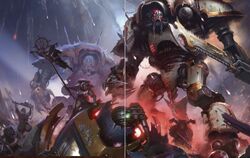
On the Forge World of Nysairene Delta, a lance of Chaos Knights drawn from across the galaxy marched at the fore of a vast heretical army, slaughtering the Imperial warriors who had arrived on-world as part of the Indomitus Crusade. Among those slain by the Questor Traitoris war engines were several Knights of the Loyalist House Terryn, whose blasted chassis were trampled ingloriously into the ash and mud.
A Noble is enabled to pilot their war machine by being wired into an arcane contraption that is implanted into their Knight's cockpit -- a Throne Mechanicum in the larger Knights, or a Helm Mechanicum in the smaller classes. Neural jacks and cerebral uplinks connect the pilot's nervous system to the device, allowing them to directly interface with the machinery of their steed.
Actuators and omni-motivators are driven by streams of hateful thoughts, whilst sensory information and multi-spectrum Auspex relays feed back into the Noble's mind with burning clarity. Within each Throne Mechanicum are the spectral neural echoes of its previous pilots, screaming techno-gheists whose suffering increases exponentially as the Knight to which they are bonded grows ever more warped.
Only the most indomitable Fallen Nobles are able to commune with a Throne Mechanicum. Those that do are able to spur their Chaos Knight into action by inimical will alone. Nobles who are wired into a Helm Mechanicum are similarly twisted by Chaos energies that have been absorbed by their war engine. The Helms also yoke these pilots mind and soul to the will of their Knightly overlords.
Since the Horus Heresy, thousands of individual Knights and even whole Knight houses have fallen to Chaos. Each instance of treachery is a monumental blow to the Imperium. The Nobles and their Knight suits are not only crucial cogs in humanity's war machine, they are considered to be among the most unshakeably loyal servants of the Emperor.
The mere suggestion that a Noble could forswear their vows and fight against the Imperium's servants is tantamount to blasphemy. It is whispered that the Departmento Munitorum has had Imperial officers executed for heresy rather than acknowledge their claims that they have done battle with turncoat Nobles. Yet the terrifying reality is that Chaos Knights bent on anarchy and slaughter march upon the Emperor's realm in ever-greater numbers.
Fallen Nobles embark on campaigns of destruction for many reasons. Some do so to conquer territory in the name of the baleful deities they worship. Others have sworn fealty to the Dark Mechanicum, the Heretic Astartes or powerful daemonic entities, and answer the dread summons of war whenever they are called upon.
Others still are driven by insanity and profane visions, launching quests to upend the very fabric of existence and transform the galaxy into a twisted hellscape.
Chaos Knights are able to cover enormous distances when battling across a planet, marching unhindered through toxic atmospheres and across irradiated continents to reach their enemies. When their wars stretch beyond a single world, many of their kind use corrupted Dark Mechanicum Explorator craft and mass conveyance barges to transport themselves to the front lines. On the most Warp-drenched battlefields, the horrific war engines have even been known to storm forth from tears in reality, emerging from local Warp rifts called into being by the powers of Chaos.
A single Chaos Knight has as much resilience and firepower as a small army. Those that have turned upon or even butchered the rest of their Knightly household are termed Dreadblades by the Ordo Hereticus. They typically operate as lone wolves and mercenaries, lending their immense might to heretical warlords in exchange for powerful relics, arcane knowledge or fief planets upon which they can enact their cruelties.
Dreadblades are often followed into battle by hordes of warriors, Chaos Space Marines who revere the Knights' destructive potential, and throngs of Chaos Cultists who worship the machines as manifestations of their Dark Gods' will. At other times, multiple Dreadblades will gather together, focusing their disparate fury towards a single malefic purpose.
But even more terrifying than the individualistic Dreadblades are the Knight houses that have fallen in their entirety to Chaos. Those that have sided with Traitor Titan Legions and the Dark Mechanicum are known as "Infernal houses" in the Imperium. They use techno-sorcery and summoned daemonic entities to bolster the already formidable capabilities of their Knight suits.
Other Knightly courts, known as "Iconoclast houses," have more varied heretical allegiances; some have maintained oaths of fealty to Heretic Astartes Legions or the Dark Gods themselves, whereas others have renounced their allegiance to the Imperium to carve out their own dread empires.
History

A Renegade Questoris-class Knight faces a Knight of House Krast.
A Legacy of Betrayal
The history of the Chaos Knights stretches back into the dark recesses of humanity's past. Long before the Emperor arose on Terra and forged the Imperium of Man, the Knights had established their bastions on worlds across the galaxy. Through countless horrors and long millennia they endured -- but even they were not immune to the corruptions of the Warp.
The first Knight houses were established shortly after humanity began expanding its domain into the stars. Groups of colonists struck out from Terra aboard Long March generation ships, travelling for solar decades or even Terran centuries through the cold void of space to reach their destination worlds.
Countless colonists were lost to empyric disasters and navigational errors, while those who arrived successfully upon their new planets were faced with all manner of extreme hardships.
Some worlds were battered by savage electrical storms or burned with unrelenting volcanic activity. Others were bathed in exotic radiation, covered in carnivorous flora or infested with strange pathogens that decimated the new arrivals.
Many planets played host to sentient indigenous species who violently resisted human encroachment, leading to bloody wars for supremacy. Yet the hardiest groups of colonists not only endured, but thrived in their new environments.
Using Standard Template Construct technology, the pioneers were able to fabricate the structures and machines they needed to assert their dominance over their new planet. Each STC database could replicate a specific creation, repeatedly and without fail. In this way the colonists built vast habitats to shield them from the ravages of their planet's atmosphere and devices to reconstitute life-giving essentials such as food, water and breathable air.
In many cases, the vessels that had transported the colonists through space were transformed into fortified enclaves that in time formed the basis for mighty fastnesses. This allowed for the creation of heavy mining tools, refineries and processing plants with which the wealth of the new worlds could be rapidly exploited.
STCs were used to create devastating machines capable of annihilating hostile alien races that offered resistance or invaded the burgeoning human domains. The first Knight suits were both tools of settlement and weapons of war, equally as capable of sawing down towering trees and crossing inimical environments as they were of gunning down hostile xenos.
Only the most skilled and forceful individuals were equal to the task of operating the Knights suits, and it was to these warriors that the other colonists turned to for protection and, eventually, leadership. Long bloodlines of pilots emerged, and they were subtly mentally conditioned by the systems of their Thrones Mechanicum to become ever-more stringent and authoritarian. These were the Nobles of the first Knight houses.
The planets over which they ruled grew insular, rejecting new advancements in technology in favour of the traditions established and enforced by the Nobles. Due to their isolationist cultures, the Knight Worlds diverged from the path taken by the rest of humanity, and in doing so were saved from the nightmares that followed.
Consumed by Strife
As rapidly as humanity expanded into the stars, the collapse of its galactic domain was even swifter. Vast distances between settled worlds led to the emergence of divergent cultures, and with these came rapid genetic evolution and mutation.
Individuals emerged with the ability to sense and manipulate the tumultuous Warp that existed parallel to realspace. On some worlds these so-called "psykers" were mercilessly persecuted, being hunted down and slaughtered wherever they were found, but on many they were revered and allowed to rule over their mundane kin.
Alongside psykers came other sub-species of Mankind -- Abhumans whose genetic pool had been irrevocably tainted by the environments in which they dwelt. Interstellar wars broke out as the ideologies of neighbouring systems grew ever-more incompatible.
Sentient machines turned violently on the masters they had been built to serve, entire planets were overrun by xenos armies, and as worlds burned, many of the wonders of the Age of Technology were lost forever. With the seething tumult came Warp Storms that tore through the void of space.
Routes of contact between humanity's manifold domains were severed, leaving distant regions cut off from one another. Their denizens were forced to face the horrors that befell them in isolation.
The Knight Worlds fared better than most in this time of terror and darkness. The Noble houses had swiftly purged mutations that had developed amongst their subjects, and had strangled branches of their own family trees where genetic deviance had appeared. From the first they had rejected thinking machines, trusting instead to hard work and personal sacrifice to make their planets strong, and so were largely spared from the rampages of the Men of Iron during the Cybernetic Revolt.
Armed with their Knight suits, they repelled xenos incursions into their domains, and crushed the savage mobs of mutated humans that came flooding in from nearby planets. The Knight houses fortified their holdings, kept watch over their worlds and endured as the human galaxy was overtaken by strife.
Over long centuries the cultures of these Knight Worlds regressed even further. Superstitions about the enemies of Old Night became enshrined in codes of Noble conduct. The technologies that had allowed their colonist forebears to survive became worn, the knowledge of their functions lost. But the Knights themselves survived, as did their traditions and the peoples whom they had sworn oaths to defend.
The Coming of the Emperor
When the Great Crusade spread across the galaxy in the late 30th Millennium, a great number of Knight Worlds were reunited with the rest of humanity. Vast fleets set out from Terra to find the remnants of Mankind that were scattered amongst the stars, and to bring them under the aegis of the Emperor of Mankind.
Many of the worlds to which the Great Crusade came were ruled over by obstinate tyrants -- warlords and despots who had risen to power during the anarchy of the Age of Strife, and who refused to humble themselves before the Emperor's might. These regimes were ended with brutal swiftness, crushed by the armies of the burgeoning Imperium.
The first account of a Knight World being rediscovered came from a Rogue Trader named Jeffers. His reports to the Administratum noted both the formidable technology of the Knight suits as well as the loyalty and staunchness of the Nobles who piloted them.
In the years that followed, hundreds of other Knight Worlds were encountered and brought into the fold. Most Noble houses were quick to swear fealty to the leaders of the Great Crusade, for in the Imperium they saw their own values of order and duty implemented on an incomparably grand scale.
Amongst the myriad organisations that made up the Great Crusade, it was the Mechanicum of Mars that was most successful in securing oaths of fealty from the Knight houses. The Martian Tech-priests coveted the ancient archeotech that existed on these planets, and were eager to exploit the rich mineral wealth of the various Knight Worlds.
Many Noble families swore their service to the Mechanicum, though others gave their loyalty directly to Terra and the Emperor. Regardless of who they pledged themselves to, the Knights loyally answered the call to war whenever it came.
In return, the Sacristan orders who tended to the Knights were inducted into the secrets of the Omnissiah, regaining many lost secrets of mechanical artifice that allowed them to better serve their masters.
Dawn of Heresy
The Great Crusade saw worlds across the length and breadth of the galaxy brought under the Emperor's almighty rule. But at its zenith the Imperium was shattered by treachery. The Imperial Warmaster Horus and fully half of the Space Marine Legions succumbed to the corruptions of the Dark Gods, and in the name of Chaos launched an apocalyptic campaign against the Imperium.
The galaxy was riven by civil war -- the Legio Astartes slaughtered their erstwhile allies, worlds were incinerated by teeming armies of Heretics, and the light of hope carried forth by the Emperor was replaced by bitter darkness. It was during this time that the first Knights fell to Chaos.
Many amongst the Imperium had thought it impossible for the Noble houses to be corrupted. The Thrones Mechanicum to which they were bonded altered the Nobles' psyche and synaptic makeup, conditioning them against harbouring thoughts of betrayal or sedition.
Indeed, the majority of the Knight Worlds fought aggressively to stem the tide of heresy, putting down any rebellious elements within their own societies before joining in the battle alongside the Loyalist Space Marine Legions. Due to their sheer power and unflagging loyalty, the Knights were crucial to the Imperial war effort on countless bloody battlefields. Yet it was this same loyalty that led some to side with the Archenemy.
Innumerable Mechanicum Forge Worlds sided with Horus, as did many of the Knight houses that had sworn undying fealty to the Tech-priests of those worlds. As the Dark Mechanicum delved deeper into the arts of profane techno-sorcery, so too were the Knights in their service tainted by Chaos.
Rune-marked Knights marched to war alongside Traitor Titan Legions, unleashing devastation upon the defenders of the Imperium. Other Fallen Houses upheld their oaths to Space Marine Legions that turned Traitor. The Nobles of these houses followed their own codes of conduct to the letter -- serving without question and answering all calls to war -- and in doing so placed themselves on the path to damnation.
Still other Knights turned upon their own houses and renounced all ties to their bloodlines. Some were swayed by the whispering of malefic entities in their dreams, whereas others were bound to the will of the Dark Gods through sorcerous rituals.
Thus were the Chaos Knights born, and in the hundred centuries since they have continued to spread death and terror throughout the stars.
Path to Damnation
Those who pilot Imperial Knights are brave and noble warriors, drawn from ancestral knightly houses. In their eighteenth standard year, aspirants face the Ritual of Becoming, a strange rite where the mind of the Noble is fused with the Knight's Machine Spirit (artificial intelligence), allowing the pilot to occupy the machine's Throne Mechanicum and control it with their thoughts alone.
This rite -- coupled with psychosuggestive subroutines fed through the Knight's cybernetic neural jacks -- is intended to weed out those who are weak in mind or soul, reinforcing notions of honour and selflessness so that few Knights risk falling to the temptations of Chaos.
No mortal man is beyond the reach of the Dark Gods, however. To believe otherwise is dangerous arrogance. There are many ways that a Knight may stray from the true path laid out in the Code Chivalric, or else be driven from it by force. Most common are those times when Freeblade Knights -- those who have already forsworn their knightly houses due to some shame or tragedy -- find themselves driven to commit ignoble acts to survive.
The ghosts of the Thrones Mechanicum are uncompromising and unforgiving, and the judgemental voices of ancestors long passed will lambaste such a fallen Knight mercilessly. Some pilots take their own lives, or abandon the Throne forever -- to a Noble pilot, there is little difference between these two terrible ends. Those who do not, or worse, cannot, are driven swiftly mad.
It is this insanity that the Dark Gods prey upon, claiming the Nobles' lost souls and twisting the Machine Spirits of their mechanical steeds into ravening beasts. In recent years, covens of Warpsmiths have taken to capturing lone Knights and giving them over for torture until this horrible end is achieved.
There are even whispered rumours that some Renegade Knights no longer contain living pilots at all, but are instead the unwilling hosts to parasitic possessor daemons who clad themselves in the war engine's adamantium plates as a mortal warrior might don a suit of armour.
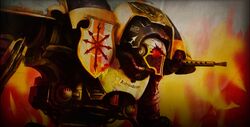
A Renegade Knight stalks its next prey in battle.
Rarer and more terrible are those instances when an entire lance, or even a whole knightly house falls into damnation. During the dark days of the Horus Heresy, this was a tragedy that played out many times, most famously with the once glorious House Devine who fell to the temptations of Slaanesh, the Prince of Pleasure. With the Cicatrix Maledictum now splitting the galaxy, such wholesale corruption has become a hazard once again.
Here, a compromised Sacristan creeps from one Throne Mechanicum to the next, tainting them with daemonic ichor brewed to drive the Knights' pilots to madness and mutation. There a Baron leads a noble crusade to purge a world of Chaos taint, only to become so immersed in blood that he and his followers degenerate into the very berserk beasts they strode out to slay.
The Inquisition's agents have gone to great pains in their efforts to suppress reports of traitorous knightly houses, for the mere notion of such loyal warriors turning Traitor is every bit as horrifying as the concept of Renegade Space Marines. Yet more Knights fall with every passing Terran year, and their devastating rampages have become difficult to conceal.
Infernal Quests
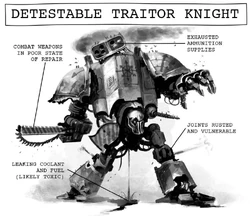
Imperial propaganda poster of a Renegade Knight
When Renegade Knights gather in great number they are compelled to swear grim oaths to the Dark Gods. In a twisted parody of their former nobility, they vow to complete mighty tasks on pain of death and dishonour.
Such deeds may include the burning of a Cardinal World or other great place of Imperial faith, the hunting of some feted Imperial hero, or the wholesale butchery of a star system whose defenders have offended the Dark Gods with their simple resistance. Once they have set themselves to such an Infernal Quest, Renegade Knights will not relent until either they emerge victorious, or they are slain to the last.
Types of Renegade Knights
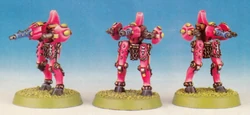
- Hell-Strider - The Hell-Strider is the smallest of the Daemon Knights, but still stands many times the height of a man. They are armed with Lascannons and short-range, Knight-sized Melta Weapons. Hell-Striders are extremely mobile, able to flush the enemy out of woods and ruins with their powerful short ranged weaponry. Given sufficient numbers, Hell-Striders are even capable of toppling a Titan, picking off their prey's Void Shields with their Lascannons before closing in for the kill with their Melta-beams.
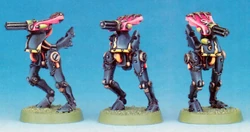
- Hell-Scourge - Hell-Scourges are one of the largest patterns of Slaaneshi Daemon Knights. As living machines in the service of the Prince of Chaos, they have crushed countless opponents in the last ten millennia, screeching deafening cries across the battlefield. They are the perfect predators, hunters who mercilessly run down their quarry with the bounding strides of their elegant, powerful legs. The Hell-Scourges attack without warning. As one appears, the enemy turn their weapons on its blurred form, only to see it disappear. At that moment, others attack from all sides, mowing through armour and flesh with their massive Castigator Cannons. Hell-Scourges possess a certain pack instinct and are in constant telepathic communication with each other. As such, they make exceptionally well co-ordinated assaults, out-flanking their enemies with ease. This telepathic contact seems to encompass all Hell-Scourges present on the battlefield, or perhaps even further. This enables Hell-Scourge detachments exceptional flexibility on the battlefield.
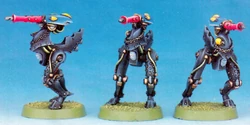
- Hell-Knight - Hell-Knights are one of the most specialised types of Daemon Knights. Aside from Bolters, their main weapon is a Thermal Cannon which, albeit short-ranged, has enough power to pierce almost any armour plate with relative ease. Hell-Knights are often used to hunt down enemy Knights and Titans, exploiting their speed to attack from the sides and overwhelm opponents. In addition to this, they are perfectly suited to perform ambushes, and are often used in this respect. A notable exploit of the Hell-Knights took place on the Hive World of Kado as part of a massive daemonic incursion. Imperial forces and the Titans of the Legio Crucius suffered grave losses in the defence of that world's capital hive city. As the Titans fired upon the advancing hordes of Chaos, felling hundreds upon hundreds of daemons and Heretics, a large force of Slaaneshi Daemon Knights infiltrated the hive city's massive subterranean transportation network. As the battle raged above them, the Chaos walkers sped through the dimly lit tunnels and corridors, quickly obliterating any resistance they encountered. On the second day of the hive city's siege, the Daemon Knights emerged from beneath the ground and burst into the main streets and arcades of the city, indiscriminately destroying everything, killing thousands of helpless citizens. The transports of the Adeptus Arbites arrived, but these too were totally crushed and the Hell-Knights fought their way back to the surface. They emerged within firing distance behind the Titans of the Legio Crucius. With a single massed salvo from the Daemon Knights' Thermal Cannons, nearly the entirety of the Loyalist Titan battlegroup was destroyed, the august forms of the Titans turned into molten slag. Amongst the victims of this attack was the colossal Praeco Deictus, an Imperator-class Battle Titan which had survived the grim days of the Horus Heresy and brought victory to the Imperium on over a thousand worlds. As Hell-Knights are super heavy they cannot be pinned in combat except by other super heavy vehicles or Titans. Anything smaller than this is simply pushed aside by the massive war machine. Hell-Knights are excellent at infiltrating enemy positions, setting ambushes for enemy supply columns and attacking enemy support detachments and artillery.
- Renegade Knight Questoris - This class includes the Chaos-corrupted versions of the most commonly employed Imperial Knight Patterns, including the Knight Errant, Knight Paladin, Knight Warden, Knight Gallant, Knight Crusader, Knight Preceptor, and the Questoris Knight Styrix and Questoris Knight Magaera during the days of the Great Crusade and the Horus Heresy.
- Renegade Knight Dominus - This class includes those Dominus-class Knights, such as the Knight Castellan and the Knight Valiant, that have been turned to the service of the Dark Gods.
- Renegade Armiger - The Renegade Armigers are those light-weight, Armiger-class Knights like the Armiger Helverin and the Armiger Warglaive that have been seduced by the promises of Chaos.
Wargear
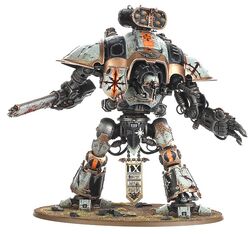
A Renegade Knight Paladin armed with Thunderstrike Gauntlet, Reaper Chainsword and Ironstorm Missile Pod in service to the Ruinous Powers.
Renegade Knight Questoris
- Reaper Chainsword
- Thunderstrike Gauntlet
- Heavy Stubber
- Ion Shield
- Titanic Feet
- Twin-linked Icarus Autocannon or Stormspear Rocket Pod or Ironstorm Missile Pod
- Avenger Gatling Cannon and built-in Heavy Flamer (As replacement for Thunderstrike Gauntlet or Reaper Chainsword)
- Rapid-Fire Battle Cannon and built-in Heavy Stubber (As replacement for Thunderstrike Gauntlet or Reaper Chainsword)
- Thermal Cannon (as replacement for Thunderstrike Gauntlet or Reaper Chainsword)
- Meltagun (as replacement for Heavy Stubber)
Renegade Knight Dominus
- Plasma Decimator
- Volcano Lance
- 2 Shieldbreaker Missiles
- 2 Twin-linked Meltaguns
- 2 Twin-linked Siegebreaker Cannons
- Ion Shield
- Titanic Feet
- Conflagration Cannon and Thundercoil Harpoon (As replacements for Plasma Decimator and Volcano Lance)
- 2 Shieldbreaker Missiles (As replacement for one Twin-linked Siegebreaker Cannon)
Renegade Armiger
- 2 Armiger Autocannons
- Heavy Stubber
- Ion Shield
- Thermal Spear and Reaper Chain-cleaver (As replacements for both Armiger Autocannons)
- Meltagun (As replacement for Heavy Stubber)
Notable Renegade Knight Houses
- House Ærthegn - Accepted amongst the ranks of the Imperial Knight Houses by the writ of Horus, and treated by their peers with disdain and wary hostility, the Knights of House Ærthegn were masters of the marauder's bloody trade. Following the Archtraitor's defeat, House Ærthegn was driven along with the rest of the Traitor Legions into the Eye of Terror, where they remain to this day. They serve Chaos Undivided.
- House Arcanus - House Arcanus is a Renegade Knight House that fell to the service of Tzeentch and was among the forces in service to the Changer of Ways that successfully invaded the Stygius Sector, during the Stygius War.
- House Atrax - Founded sometime during the Age of Strife and rediscovered during the Great Crusade by the dour Mechanicum Tech-adepts of the Forge World of Cyclothrathe in the latter 30th Millennium, this unfortunate Knight House from the world of Arrian was forced into indentured servitude in accordance with the Sidon Protocols. These unfortunate circumstances led to House Atrax's tragic fall during the Horus Heresy. At the end of this tragic conflict, House Atrax, along with the rest of the Traitor Legions, were driven into the Eye of Terror. House Atrax served Chaos Undivided.
- House Caesarean - During the Horus Heresy this Knight House threw their lot in with the Traitor forces of the Warmaster Horus. Notably, they took part in the Battle of Tallarn as part of the first Traitor reinforcements and provided support to the Legio Krytos. During that campaign they faced the Loyalist Legio Gryphonicus Titan Maniples in Tallarn's southern polar regions.
- House Chromatic - House Chromatic is a Renegade Knight House that fell to the service of Tzeentch and was among the forces in service to the Changer of Ways that successfully invaded the Stygius Sector, during the Stygius War.
- House Devine - House Devine fell under the sway of Slaanesh, and was the first of the Knight Houses to betray the Imperium of Man and the Mechanicum. On the planet of Molech, the sudden defection of House Devine proved to be the pivotal factor in the defeat of the Loyalist forces seeking to halt Horus' relentless advance on Terra. At the end of this tragic conflict, filled with righteous indignation, a combined strike force of Knights from Houses Cadmus, Terryn and Borgius annihilated the turncoats of House Devine as Imperial forces reclaimed Molech.
- House Drakon - During the dark days of the Occlusiad War, in 550.M37, for the first time in thousands of Terran years, a knightly house betrayed its oaths of loyalty, joining the Apostles of the Blind King to cause ruinous destruction across the northwestern fringe of the Milky Way Galaxy. Though the Blind King's rogue Tech-priests were eventually defeated, the traitorous Knights of House Drakon remain unaccounted for.
- House Drear - House Drear is a Renegade Knight House that fell to the service of Nurgle and was among the forces in service to the Plague God that successfully invaded the Realm of Ultramar during the Plague Wars.
- House Felcarn - There is little information on this formerly loyal knightly house in Imperial records. It is said that House Felcarn became corrupted from within by Chaos. Rumours state that a single surviving member of that family somehow escaped the subsequent Inquisitorial purges, proving his innocence, and went on to prove himself as the Freeblade known as "Penitent Blade," through his tireless efforts to rid his world of the Chaos Cults that plagued it. House Felcarn served Chaos Undivided.
- House Gotrith - House Gotrith is a Knight House that betrayed the Emperor during the Horus Heresy and provided support to the Legio Mortis during the Battle of Beta-Garmon.
- House Hyboras - House Hyboras is a Renegade Knight House that repudiated its oath of loyalty to the Imperium of Man during the Horus Heresy. It provided support to the Legio Vulpa during the Battle of Beta-Garmon.
- House Hydrax - House Hydrax is a Knight House that betrayed the Emperor and joined the Warmaster Horus' forces during the Horus Heresy. Later in that conflict they fought alongside House Medusos against the Loyalist Knights of House Chimaeros and House Draconis of the Knight World of Adrastopol led by their High King Rhoderic Chimaeros. House Hydrax served Chaos Undivided.
- House Ioeden - House Ioeden is a Renegade Knight House formerly of the Questor Mechanicus that repudiated its oath of loyalty to the Mechanicum and the Imperium of Man during the Horus Heresy. It provided support to the Legio Vulpa during the Battle of Beta-Garmon.
- House Ju'll - There is little information on this formerly loyal knightly house in official Imperial records or from what world they originally hailed from. All that is known is that they were allied to the traitorous Legio Mortis Titan Legion. Its fate is unknown. House Ju'll served Chaos Undivided.
- House Kepsydra - House Kepsydra is a Renegade Knight House that repudiated its oath of loyalty to the Imperium of Man during the Horus Heresy. It provided support to the Legio Krytos at the Battle of Beta-Garmon.
- House Makabius - Transformed by the century-long civil war that had engulfed their homeworld of Baroda in the Grail Abyss, House Makabius was always known for its bellicose temper, and some would even say avarice and recklessness. Makabius served Mortarion the Reaper, Primarch of the grim Death Guard Legion, during the Horus Heresy. At the end of that tragic conflict, House Makabius, along with the rest of the Traitor Legions, were driven into the Eye of Terror.
- House Mandrakor - An intermittent passage through the Great Rift was discovered in the early 42nd Millennium, yet it brought little hope to the Imperium. The Cicatrix Maledictum had at least one gap, although others were reported but not confirmed. The passage was near the Eye of Terror, which had been avoided by Navigators since the Great Crusade, for Warp Storms and strange anomalies had always made the region too dangerous to travel. There, when the swirling nebula lulled, was revealed the Nachmund System, near to Agripinaa on the near side of the rift. The Tyrant King of its primary world, Kaligius, ruled over a House of Renegade Knights on the world of Dharrovar that had not been seen since the Horus Heresy. Claiming Old Night had returned to plague the galaxy once more, Kaligius rejected communications from the Imperium, instead making pacts with Renegades and pirate fleets. Some starships have run the Nachmund Gauntlet successfully, but many more have been destroyed attempting the journey -- the ruined hulks of innumerable craft hang suspended in space as a voidship graveyard.
- House Morbidia - House Morbidia started its existence as one of the very first Knight Households in service of the Omnissiah's priesthood on Mars and was one of the early rivals of the legendary Knights of Taranis and House Zavora. Yet where these Houses were to rise high in the esteem of the Martian priesthood, House Morbidia would fall in disgrace; sparking an internecine war that would see it defeated and shackled to the will of the Fabricator-General. Its final fate is unknown. It served Chaos Undivided.
- House Mordred - House Mordred is a Renegade Knight House formerly of the Questor Mechanicus that repudiated its oath of loyalty to the Mechanicum and the Imperium of Man during the Horus Heresy. It provided support to the Legio Suturvora during the Battle of Beta-Garmon.
- House Medusos - House Medusos is a Knight House that betrayed the Emperor and joined the Warmaster Horus' forces during the Horus Heresy. Later in that conflict they fought alongside House Hydrax against the Loyalist Knights of House Chimaeros and House Draconis of the Knight World of Adrastopol led by their High King Rhoderic Chimaeros. House Morbidia served Chaos Undivided.
- House Niagma - House Niagma is a Renegade Knight House formerly of the Questor Mechanicus that repudiated its oath of loyalty to the Mechanicum and the Imperium of Man during the Horus Heresy. It provided support to the Legio Vulpa during the Battle of Beta-Garmon.
- House Oroborn - House Oroborn was a Questor Mechanicus Knight House that turned Renegade during the Horus Heresy and provided Knight support to the Legio Mortis at the Battle of Beta-Garmon.
- House Perdaxia - There is little information on this formerly loyal knightly house in official Imperial records or from what world they originally hailed from. During the outbreak of the Horus Heresy, they answered the call of the mad Archmagos Inar Satarael, and willfully took part in the Invasion of Paramar V. They also provided Knight support to the Legio Fureans at the Battle of Beta-Garmon. House Perdaxia served Chaos Undivided.
- House Rajha - There is little information on this formerly loyal knightly house in official Imperial records or from what world they originally hailed from. During the outbreak of the Horus Heresy, the ghost-grey Knights of House Rajiha answered the call of the mad Archmagos Inar Satarael, and willfully took part in the Invasion of Paramar V and the Battle of Beta-Garmon where they provided Knight support to the Legio Fureans.
- House Senica - There is little information on this formerly loyal knightly house in official Imperial records or from what world they originally hailed from. All that is known is that they were allied to the traitorous Legio Mortis Titan Legion. House Senica served Chaos Undivided.
- House Slughorn - House Slughorn is a Renegade Knight House that fell to the service of Nurgle and was among the forces in service to the Plague God that successfully invaded the Realm of Ultramar during the Plague Wars.
- House Turbidos - House Turbidos was a Renegade Knight House that participated in the Battle of Beta-Garmon during the Horus Heresy and provided support for the Legio Tempestus.
- House Vextrix - House Vextrix was a Questor Mechanicus Knight House that turned Renegade during the Horus Heresy and provided Knight support to the Legio Mortis at the Battle of Beta-Garmon.
- House Vyridion - House Vyridion was a Household of Imperial Knights native to the world of Highrock that existed at the foundation of the Imperium of Man. Through treachery and to their ever-lasting shame, House Vyridion broke its vows of fealty to the Imperium and joined the forces of the Warmaster Horus Lupercal. Yet, House Vyridion recognised the error they had made and broke all ties with their former allies. House Vyridion was called upon by the Emperor's own bodyguard, the Legio Custodes, to fight alongside them in defence of the Imperial Webway Project in the dungeons of the Imperial Palace.
- House Xerathon - House Xerathon was a Questor Mechanicus Knight House that turned Renegade during the Horus Heresy and provided Knight support to the Legio Mortis at the Battle of Beta-Garmon.
- House Wyvorn - Once a loyal House of Imperial Knights from the proud Knight World of Adrastapol, House Wyvorn is now a mere footnote in Imperial history, the entire House having been declared reductum hereticum extremis by the High Lords of Terra following their betrayal during the Donatos Uprising. House Wyvorn served Chaos Undivided.
- Rusthounds - The Rusthounds are a Renegade Knight House in service to the Plague God Nurgle who are all former members of House Krast, a Questor Mechanicus House long in service to the Adeptus Mechanicus.
See Also
- Titans
- Titan Weapons
- Titan Legions (List)
- Collegia Titanica
- Chaos Titan
- Traitor Titan Legions
- Imperial Knight
Sources
- Adeptus Titanicus - The Horus Heresy: Rulebook (Specialty Game), pg. 16
- Adeptus Titanicus - The Horus Heresy: Titandeath (Specialty Game), pg. 95
- Codex: Chaos Knights (8th Edition), pp. 3-39, 52-58, 68-69
- Codex Heretic Astartes - Death Guard (8th Edition), pg. 22
- Index: Chaos (8th Edition), pg. 108
- Index: Renegade Knights (8th Edition), pp. 2-5
- Kingsblade (Novel) by Andy Clark, Ch. 9
- The Master of Mankind (Novel) by Aaron Dembski-Bowden, Chs. 3, 8, 12, 15, 17, 20, 22, 24
- Warhammer 40,000: Rulebook (8th Edition), pp. 53, 158-159, 164-165
- White Dwarf 190 (UK), "Epic: Slaanesh War Machines," pp. 27-31
- White Dwarf 182 (UK), " 'Eavy Metal: Forces of the Imperium," pg. 38; "Titan Legions: Knight Households," pp. 39-40
- White Dwarf 180 (UK), " 'Eavy Metal: Imperial Knights", pg. 26
- Forge World Chaos Knight
- Warhammer Community - You Asked for Renegade Knights..You Got 'Em
